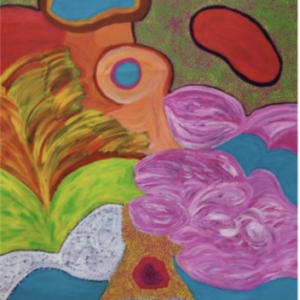Description
As far as Feminist symbols go, there are few as iconic as Rosie the Riveter. In Siren Doo Bop, Johnny Romeo puts a fiendishly feline twist to the beloved wartime tough gal, ingeniously mashing together Rosie’s defiant ‘we can do it’ pose with the latex- clad ferocity of Michelle Pfeiffer’s Cat Woman, from Tim Burton’s 1992 film ‘Batman Returns’. The painting drips with an upbeat defiance that calls on the audience to channel their inner superhero by evoking both Cat Woman’s superhero abilities and the heroism of everyday women working the wartime frontline. Cat Woman’s demure, feline tendencies, captured in the crossed-out word assemblage ‘Go Meow’ are eschewed in the painting for Rosie the Riveter’s butch commitment to hard work and dedication, cheekily expressed in the passage ‘Go Flex’. Romeo, however, doesn’t entirely overlook the seductive qualities of the leading femme fatale in the Batman Universe, referencing her reputation as Gotham City’s number one siren (alongside Harlequin and Poison Ivy) in the title Siren Doo Bop. References to jazz also abound in the work’s title through ‘Doo-Bop’, the name of Miles Davis’ last studio album, which was released in 1992, the same year as Batman Returns. ‘Doo-Bop’ marked a turning point for Davis, who worked with hip hop producers and MCs for the first time in his celebrated career after decades of being a leading influence on the genre. Davis’ interconnected relationship with jazz and hip hop is further reflected in the word assemblage ‘Go Flex’, a slang term used in hip hop to refer to extravagant boasting and showing off.







